Diagnosis of multiple cancer types by shrunken centroids of gene expression
- PMID: 12011421
- PMCID: PMC124443
- DOI: 10.1073/pnas.082099299
Diagnosis of multiple cancer types by shrunken centroids of gene expression
Abstract
We have devised an approach to cancer class prediction from gene expression profiling, based on an enhancement of the simple nearest prototype (centroid) classifier. We shrink the prototypes and hence obtain a classifier that is often more accurate than competing methods. Our method of "nearest shrunken centroids" identifies subsets of genes that best characterize each class. The technique is general and can be used in many other classification problems. To demonstrate its effectiveness, we show that the method was highly efficient in finding genes for classifying small round blue cell tumors and leukemias.
Figures
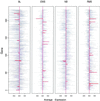
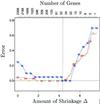

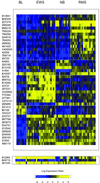
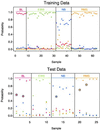
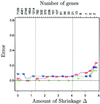
Similar articles
-
Simultaneous variable selection and class fusion for high-dimensional linear discriminant analysis.Biostatistics. 2010 Oct;11(4):599-608. doi: 10.1093/biostatistics/kxq023. Epub 2010 May 26. Biostatistics. 2010. PMID: 20505058
-
Classification of multiple cancer types by multicategory support vector machines using gene expression data.Bioinformatics. 2003 Jun 12;19(9):1132-9. doi: 10.1093/bioinformatics/btg102. Bioinformatics. 2003. PMID: 12801874
-
Improved centroids estimation for the nearest shrunken centroid classifier.Bioinformatics. 2007 Apr 15;23(8):972-9. doi: 10.1093/bioinformatics/btm046. Epub 2007 Mar 24. Bioinformatics. 2007. PMID: 17384429
-
[The clinical significance of fluorocytometry of the cell cycle in acute lymphoblastic leukemias in children].Rev Med Brux. 1988 Oct;9(7-8):367-74. Rev Med Brux. 1988. PMID: 3055136 Review. French. No abstract available.
-
Gene expression profiling in acute myeloid leukemia.Curr Opin Hematol. 2005 Jan;12(1):76-81. doi: 10.1097/01.moh.0000149610.14438.9a. Curr Opin Hematol. 2005. PMID: 15604895 Review.
Cited by
-
Implementing Mass Cytometry at the Bedside to Study the Immunological Basis of Human Diseases: Distinctive Immune Features in Patients with a History of Term or Preterm Birth.Cytometry A. 2015 Sep;87(9):817-29. doi: 10.1002/cyto.a.22720. Epub 2015 Jul 17. Cytometry A. 2015. PMID: 26190063 Free PMC article.
-
A Simple Method for Estimating Interactions between a Treatment and a Large Number of Covariates.J Am Stat Assoc. 2014 Oct;109(508):1517-1532. doi: 10.1080/01621459.2014.951443. J Am Stat Assoc. 2014. PMID: 25729117 Free PMC article.
-
An investigation of biomarkers derived from legacy microarray data for their utility in the RNA-seq era.Genome Biol. 2014 Dec 3;15(12):523. doi: 10.1186/s13059-014-0523-y. Genome Biol. 2014. PMID: 25633159 Free PMC article.
-
Peptidomic Identification of Serum Peptides Diagnosing Preeclampsia.PLoS One. 2013 Jun 19;8(6):e65571. doi: 10.1371/journal.pone.0065571. Print 2013. PLoS One. 2013. PMID: 23840341 Free PMC article.
-
Identification of a multi-cancer gene expression biomarker for cancer clinical outcomes using a network-based algorithm.Sci Rep. 2015 Jul 23;5:11966. doi: 10.1038/srep11966. Sci Rep. 2015. PMID: 26202601 Free PMC article.
References
-
- Golub T, Slonim D, Tamayo P, Huard C, Gaasenbeek M, Mesirov J, Coller H, Loh M, Downing J, Caligiuri M, et al. Science. 1999;286:531–536. - PubMed
-
- Hedenfalk I, Duggan D, Chen Y, Radmacher M, Bittner M, Simon R, Meltzer P, Gusterson B, Esteller M, Raffeld M, et al. N Engl J Med. 2001;344:539–548. - PubMed
-
- Hastie T, Tibshirani R, Friedman J. The Elements of Statistical Learning; Data Mining, Inference and Prediction. New York: Springer; 2001.
Publication types
MeSH terms
Substances
Grants and funding
LinkOut - more resources
Full Text Sources
Other Literature Sources
Medical

